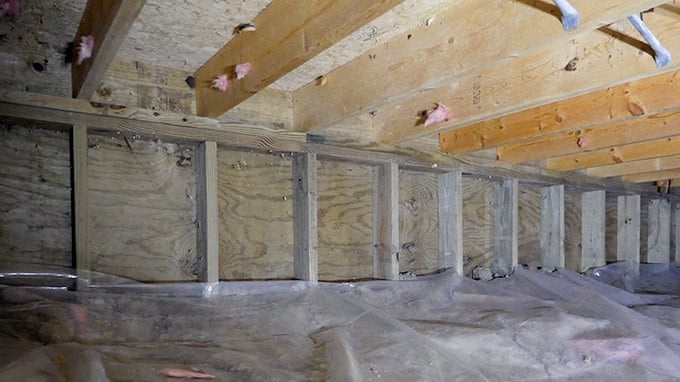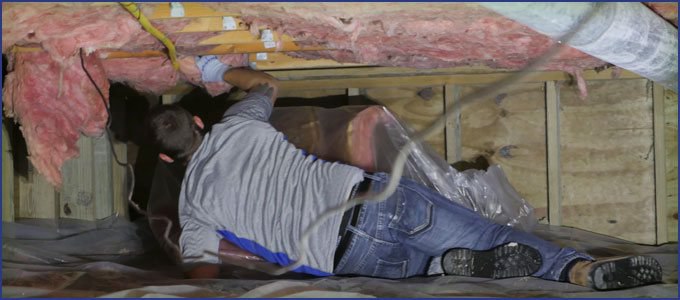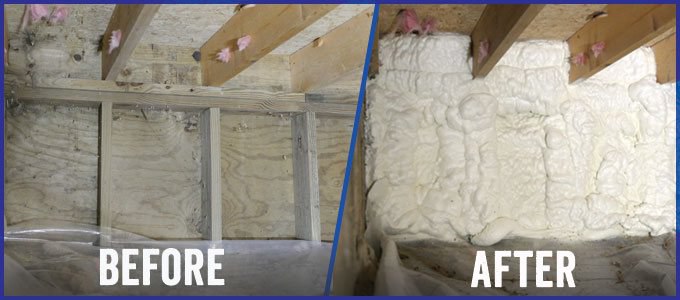How to Insulate a Crawl Space


You’ve finally had enough of cold floors and done the research on insulation, now you just need to know how to insulate a crawl space.
Little to no insulation in your crawl space is always the culprit that leads to cold floors and uncomfortable homes. Other problems you may be experiencing include frozen pipes, high monthly energy bills, excess moisture, and mold and rot issues.
RetroFoam of Michigan has more than 20 years of experience insulating thousands of crawl spaces across the lower peninsula, so we know exactly how to get the job done no matter what the insulation material is.
Let's get started.
How to Insulate a Crawl Space
As part of our ongoing efforts to educate homeowners, we will discuss the most popular options to insulate a crawl space in Michigan, including using fiberglass or spray foam insulation.
We will also discuss the cost to insulate the crawl space, as well as the pros and cons of each material.
Fiberglass Insulation for Crawl Space

Fiberglass insulation is a material made of plastic that is reinforced with extremely fine glass fibers.
This composition gives the plastic additional strength while improving its insulation capacity.
Pros vs Cons of Fiberglass Crawl Space Insulation
When it comes to handling and installing fiberglass insulation, there are a few pros and cons to keep in mind.
Fiberglass is a budget-friendly option and can be a DIY project, but you have to be super careful when handling it. The tiny glass fibers can get into your skin and eyes, and if you breathe them in, they can even lodge in your lungs. That's why it's crucial to suit up with protective clothing, goggles, and gloves, which can add to your costs.
Another thing to consider is that fiberglass insulation doesn't create an air barrier, so you might still feel that chilly draft sneaking into your home. Plus, it tends to hold onto moisture, which can lead to mold and mildew.
How to Install Fiberglass Insulation in a Crawl Space
You can install fiberglass insulation yourself if you're handy, or you can hire a contractor to do it.
When installing fiberglass, you must wear goggles, long pants, long-sleeved shirts, masks, and gloves. Tiny fiberglass particles can get into your skin, eyes, and even your lungs, causing serious issues.
Before you start, make sure to remove any old insulation from your crawl space. Starting fresh is the way to go, especially if you've had problems with air leaks or moisture in the past.
For crawl space insulation, you'll typically staple the batts into place. Just make sure to cut them to fit perfectly, or you'll end up with gaps that let air sneak in.
Fiberglass Insulation Cost
Not every crawl space is created equal, meaning the cost to insulate it with fiberglass insulation varies depending on the size of the area.
The cost to hire an experienced contractor is higher than if the homeowner installs the material themselves.
Making the fiberglass insulation installation a DIY project is a cheaper option, but the homeowner must also take into consideration the cost of materials like goggles, gloves, and masks.
It is also important to note that if there are any problems with the DIY installation, the project could end up costing the homeowner even more money.
Crawl Space Spray Foam Insulation

Spray foam insulation is a water-blown and organic chemical compound derived from petroleum extracts.
In most cases, an open cell spray foam is used in the crawl space. Open cell spray foam can expand up to 100 times its original size to fill every nook and cranny in the crawl space area.
Pros and Cons of Spray Foam Insulation in Crawl Space
Open cell spray foam creates an air seal that will eliminate cold floors and high energy bills.
If you've had moisture problems in the past, a good thing to note is that spray foam insulation in the crawl space doesn't retain or absorb water.
While fiberglass can be installed as a DIY project, that’s not the case with spray foam insulation. Because the material is so complex, it is highly recommended the material be installed by an experienced contractor.
How to Insulate a Crawl Space with Spray Foam
Crawl spaces can be insulated with spray foam in one of two ways – either the crawl space walls or the underside of the floor of the house can be insulated.
The determination of which area to insulate is based on whether there is ductwork or a furnace in the crawl space.
If there are heat ducts in the crawl space, the exterior walls would be sprayed, and plastic would be laid on the ground. If there are no ducts, the underside of the floor is a better option.
Crews first must remove any old insulation in the crawl space, which gives them a bare canvas on which to install the spray foam.
The following day another crew comes and runs a hose to the crawl space and sprays the foam either on the walls or floor bottom.
Spray Foam Insulation Cost
Much like fiberglass, the cost to insulate a crawl space with spray foam insulation depends on the size of the area.
Another major factor is whether the exterior walls or the underside of the floor are being insulated because that changes the size of the project.
Choosing the Best Insulation for Your Crawl Space
Now that you know the best insulation materials to insulate a crawl space and how to install them, it’s time to make a decision.
If you’re leaning more towards spray foam insulation and want to learn more about the benefits, check out our Learning Center.
If you have made the decision to use spray foam insulation in the crawl space and live in Michigan’s lower peninsula, give us a call at 866-900-3626 for a free estimate, or fill out the form on our website.
Related Articles
DIY Spray Foam vs Hiring a Contractor: Which is Best?
Does My Dirt Floor Crawl Space Need a Vapor Barrier?
Crawl Space Encapsulation vs Insulation: What’s the Difference?
About Amanda Ringler
Amanda previously has worked as a breaking news and crime reporter, TV news producer, and editor in Flint and Detroit. Throughout her career as a journalist, she has won several awards from The Society of Professional Journalists - Detroit Chapter and the Michigan Press Association. As part of the RetroFoam of Michigan family, Amanda uses her experience as a journalist to write content that will help educate homeowners on the benefits of foam insulation. When Amanda isn’t writing, she’s spending time with her husband and rescued huskies. She also loves knitting, making art, cooking, and hosting dinner and a movie night for friends and family.

.jpg)
